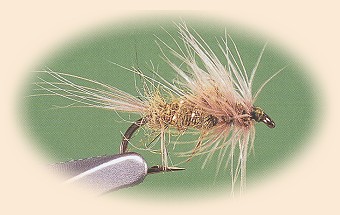
On The Fly
"Fly tying is a school from which we never graduate"
TYING NEWS
Those of you who knew Rusty Randall lost a good friend last month. We have all
lost a genuine folk hero, an unselfish teacher, and a wealth of fly fishing and tying knowledge.
Under his gruff exterior was a soft and giving soul. His humor and wit was his signature, his
favorite fly was anything tied with Peacock, his passion was helping others in the sport. I am
proud to have been his friend and will miss his influence.
The Southern Oregon Fly Tiers met Tuesday, July 8th, at the Madrone Hill
community building near Gold Hill. We had a swap meet and bar-b-q. All in attendance had a good
meal and picked up some real bargains. In August our guest tier will be Dave Roberts. I
encourage novice and experienced tiers alike to drop by the second Tuesday of each month at 6:30
p.m. for a fun evening, we have plenty of room for everyone. If you are interested in this
educational experience, contact me and we will add your address to our e-mail list. We can let
you know who, when, and what materials to bring.
 PATTERN OF THE MONTH - Little Olive Flymph
PATTERN OF THE MONTH - Little Olive Flymph
Hook: Daiichi 1710 or equal, 2X nymph, size 12-16.
Thread: Olive 8-0.
Hackle: Medium blue dun hen.
Tail: Medium blue dun hen.
Rib: Oval gold tinsel.
Body: Mix of olive fur and Antron.
Tying Instructions:
1) Start the thread one eye-width back from the eye. Select a hen hackle with fibers 1 to 2
times the hook gap. Tie in the feather ?xa0;with the tip over the front of the hook, the convex
side against the shank.
2) Select six to ten hackle fibers, measure them the length of the shank, and tie them on just
above the barb.
3) Tie in 2-3 inches of the gold tinsel at the base of the tail.
4) Form a dubbing loop and insert the spiky dubbing loosely between the threads of the loop.
Twist the loop to form a dubbing rope and wind it forward to the hackle tie-in point. Tie off
and trim.
5) Wind the ribbing forward in 4-6 evenly-spaced turns. Tie off and trim. Return the working
thread to the mid-point of the body in one long turn towards the rear.
6) Take one turn of hackle at the hook eye. Place a second turn just behind the first, take
another turn halfway to the thread, then the final turn at the mid-point of the body. Capture
the hackle under a couple turns of thread and trim off excess, then work the thread forward
through the hackle to the eye. Form a neat head, whip-finish and apply cement.
“Flymph—A wingless artificial fly with a soft, translucent body of fur or wool
which blends with the undercolor of the tying silk when wet, utilizing soft hackle fibers easily
activated by the currents to give the effect of an insect alive in the water, and strategically
cast diagonally upstream or across for the trout to take just below or within a few inches of
the surface film.”
The text above was quoted from The Art of Tying the Wet Fly & Fishing the
Flymph by James E. Leisenring and Vernon S. Hidy, and published in 1971. The history of the
Flymph goes back to England and the Stewart Spider documented in the 1600s. “Soft-hackle
nymphs,” “wingless wets,” “tailed soft hackles,” “flymphs.” Whatever you call them, these
patterns wreak of life and are super attractive to fish of all species. Whether they indeed
imitate the stage between a nymph and an adult fly, I tend to feel, like other patterns, they
catch fish because they indicate life in a very versatile manner.
The Little Olive Flymph was developed by Dave Hughes. I was lucky enough to
attend his seminar in May, which prompted me to buy his book, Wet Flies, a very good read, which
encouraged me to write this column. Anyway, there is nothing more frustrating than trout that
refuse a matching dry during a good hatch. With close observation you can determine that the
trout are indeed focused on the emergers rather than the duns. This pattern in a matching color
could turn the odds in your favor. My advice: tie some up in different colors and sizes to match
your local hatches, and have a box-full available to fish under the hatch. Give them a test
flight and let me know how you do.
TYING TIPS
This fly is successful because of the spiky body. This can only be achieved
with a dubbing loop method. Don't twist or wind it too tightly. If the fly looks tidy, you've
made a mistake. Working the thread back through the hackle towards the eye will strengthen the
fibers without forcing them down. This is an easy tie using common materials and the variations
are endless.
Tie One On,
Dan Kellogg (you can contact me at FLYGUY@EZNORTHWEST.COM)